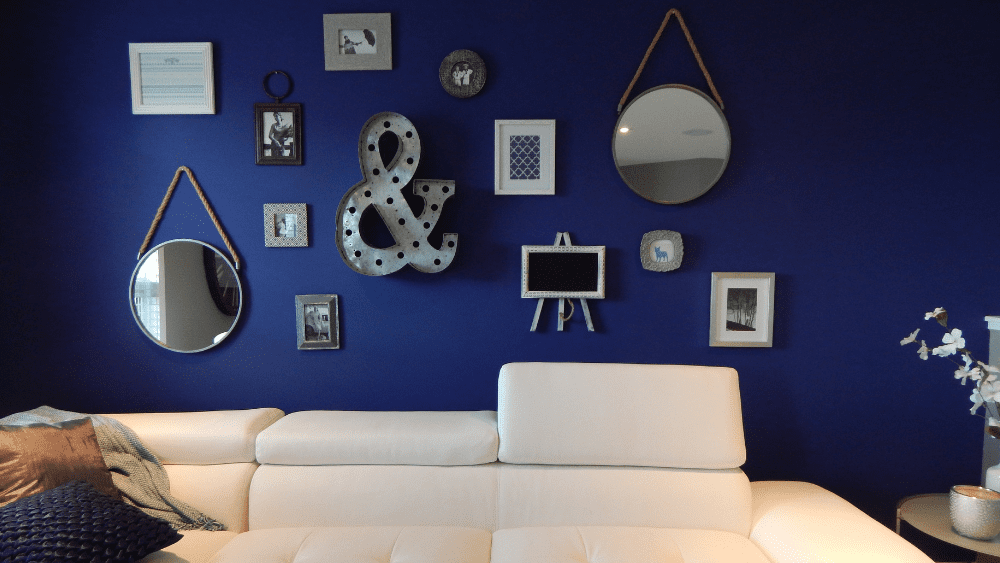
Accent walls, statement walls, feature walls — whatever you call them, they are in. These walls are a terrific way to add a little something extra to any room, but they are most commonly used in living rooms. This makes total sense since the living room is one of the most used rooms for entertaining, even just by the family. So, of course, you want to make the space look its best and anything but b-o-r-i-n-g!
In the past, if you wanted an accent wall, you’d paint it a different color than the rest of the walls in the room and call it a day. As accent walls have grown in popularity, the options have become more sophisticated. Today’s accent walls feature colors, patterns, textures, décor items and more. The only limitation is your imagination!
One of the things I love most about accent walls is that they encourage homeowners to get creative and try something new. It’s far less intimidating to create an accent wall than it is to paint your entire home interior in bright, bold colors or funky patterns. Even that one wall can totally change the feel of a room and the best part is, if you hate it, you’ve only got to re-work one wall. It’s the ideal way to try out a new look or color without making too much of an investment.
Choose Your Accent Wall
The first step in creating an accent wall is choosing the right wall. The location is important. This wall should add excitement to the room. It can be used to enhance an architectural feature, break up the monotony of a boring space or become a focal point. Many people think the accent wall should be the first wall you see when you enter a room. That’s not always the best approach. If, for example, the room is arranged so that your backs are to that wall when seated, you’ve wasted the accent wall; no one will see it.
Instead, think strategically. Consider where your eye naturally goes when entering the room. That could be a sign that the accent wall should go there. If you have architectural features like a fireplace or a large wall unbroken by doors and windows, those could be another option.
Nick Slavik, a contributor to This Old House and owner of Nick Slavik Painting & Restoration Co. in New Prague, Minnesota, reminds us to look up: “Don’t forget about the ‘fifth wall,’ otherwise known as the ceiling. In consultations for asymmetrical rooms with no dominant focal point, I’ll often offer the ceiling up as a novel method of infusing color into a challenging room.” [link: https://www.thisoldhouse.com/ideas/how-to-choose-accent-wall]
Make Your Statement
As I mentioned earlier, there really is no limit to how you create your accent wall. Here are some ideas to get you started:
- Colors. The simplest way to create an accent wall is to paint it a color that is different from the other walls. In general, accent walls look best when they are darker than the other walls, but complementary. This is especially important if the accent wall is adjacent to another wall. Use color swatches at the paint counter for a foolproof color combo.
Unsure about choosing a color? “Choose something that makes you feel good,” says Kristen Chuber, director of brand management at Paintzen.com. Look for inspiration in a favorite rug or piece of art, and then use the piece to “choose the color that stands out to you the most. Hopefully, it will give you the same happy feeling your inspiration piece did,” she says.
- Patterns. Patterns are another way to create an accent wall. Wallpaper, stencils and peel-and-stick wall coverings are all possibilities. You can find subtle, tone-on-tone designs or bold and bright designs that can make the wall pop.
- Textures. Textured walls are increasingly popular as wall and floor coverings become lighter and more versatile. Think shiplap siding, paneling, vinyl decals, stone, tile and glass, and even chalkboard paint!
- Artwork. If you have a natural focal point, like a gorgeous piece of art, work with it. Paintings are a classic choice, but wall sculptures and vinyl lettering are increasingly popular. You can even take a cue from nursery designs and create a mural wall.
- Built-ins. If you have built-in shelving, a fireplace, alcove or a staircase wall, you have an area that is just begging to become a statement wall. These existing features can pack a powerful punch when they are jazzed up a bit.
Heed These Additional Design Tips
- Don’t overdo it. The accent wall is supposed to be the focal point of the room. That means letting it have all of the attention. Don’t detract from the wall with unnecessary décor or, even worse, cover up the accent wall with clutter. Decorate in complementary hues, patterns and textures to allow the accent wall to have all of the glory.
- Subtle and understated work just fine. The accent wall does not have to be big and bold or dominating. Tone-on-tone colors, subtle patterns and colors that are just a touch darker than adjoining walls can all work perfectly.
- Uninterrupted space is best. Try to stay away from walls that have windows or door. Windows are particularly challenging because the outside view competes with the wall for your attention and the light that comes in can reduce the wall’s visibility.
What do you think of accent walls? Do you love them? Hate them? Never really gave them much thought? Visit HomLuv to browse living room designs and start imagining the accent wall possibilities.

 Getting Your Guest Bedroom Guest-Ready
Getting Your Guest Bedroom Guest-Ready